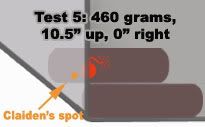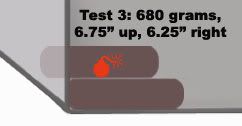completed Feb 22 2010
Blogger “Baz” first brought to my attention how there was a supposed logical elimination of the Bedford suitcase(s) that was supported by forensics tests in the United States. Interestingly, these were also overseen by two of my favorite Lockerbie frame-up characters, FBI’s J. “Tom” Thurman and Alan Ferraday of the UK Royal Armament Research and Development Establishment (RARDE). This information was found by Baz in David Leppard’s 1991 book On the Trail of Terror, which I finally own and can share some more details.
Leppard, a Sunday Times reporter and early investigation insider, called the tests “all-important,” “critical to the entire Lockerbie investigation,” and “unequivocal” in their indication the bomb came in from Frankfurt. They proved, he and others feel, that “the mysterious brown Samsonite reported by [Bedford] … could be ruled out; it was not the bomb bag. Kamboj was in the clear.” [p 141] This was done, in essence, by simply proving a fairly evident point that the suitcase wasn’t in direct contact with the main floor of container AVE4041. But Leppard’s own set up hints at the difficulty of being certain about anything here: “An inch either way could mean the difference between Frankfurt and London,” he wrote, without even noting that no one could be sure where to draw that line when moveable luggage is involved. [p 138]
The FBI arranged for these tests in early 1989; eventually coming under joint control of FBI, RARDE, and the Federal Aviation Administration (FAA). Senior Investigating Officer John Orr sent RARDE scientist Alan Feraday and Scots police DCI Harry Bell to participate, gathering with their American counterparts in mid-April at a little known center for blowing things up called the “US Naval Explosive Ordnance Disposal Technology Center” at Indian Head, Maryland. Tom Thurman represented the FBI and Walter Korsgaard was there from FAA. “Pointedly, the Germans were not invited,” Leppard noted, one might guess on account of their stubborn insistence the bomb had to have come on at London. [p 138]
The rigid, "Teutonic" Germans were supposedly shown wrong by the following five tests; five IEDs made by Ferraday were used, each contained in Toshiba RT8016 model radios, with differing amounts of Semtex-H. Each was packed similar to how the primary suitcase was thought packed – hardsided Samsonites stuffed with clothes “sprayed with a distinctive colour of paint for ease of identification.” These were then packed into containers with 45-54 pieces of “unclaimed passenger luggage obtained from the FAA’s central storage depot in Washington.” Each event was video-recorded using high-speed 16mm cameras. [p 139]
The first test on Tuesday 18 April was overseen by agent Thurman; it used 435 grams of explosive, with the suitcase placed second layer up from the floor, outboard end, “to the left of the door opening.” The center of explosion given was 7-8 inches from the floor, five inches “to the right of the first upright frame member.” [p 139] The inset here is based on my guess what that means, the door edge basically. Keeping close in line with the center of the real explosion, it should be near the (loading) front of the container, on that outboard end, and about this low. This center is about seven inches inboard (right) of the center identified by Claiden (see part 1), which I consider pretty accurate.
The second test was done the next day, 19 April, overseen by Feraday. This time a 360-gram bomb in its case was placed “on the second row of cases, to the left of the door opening – being on top of a 9” thick case (yet “four iches from the floor,” Leppard writes) and 2” to right of the first upright. [140] It would be like the above then except a bit higher and 3" further outboard (left)
The third test was carried out the “following day,” so 20 April, and overseen by FAA’s Korsgaard. A whopping 680 grams was used this time, with the suitcase in “same location as in the second test,” in being on the second layer, but 6.75” up and 6.25” to the right of the upright. [p 140]
The fourth test was again “the following day, Thursday 20 April,” which would indicate Leppard got mixed up somewhere. This one shook up the formula so as to “evaluate the effects of placing the IED directly on the container floor.” The real question at hand - could it have been the Bedford bags? 400 grams were used, placed on the bottom layer to the left of the door. Leppard writes:
“Unfortunately, the explosion partly destroyed the evidence; ‘Due to an uncontrollable fire caused by the detonation,’ a secret report by Harry Bell stated, ‘results were not easily recordable as during previous tests.’
Nevertheless, it was the fourth test which provided the critical clue the investigators were watching for. ‘Results of Test number 4 clearly indicate that the case containing the IED was not in direct contact with the container floor. That is, the the device was not in in a suitcase directly in the bottom layer of passenger baggage.’” [p 140]
 Having gotten what it seems they came for - something they could call absolution for London origin theory - they wrapped it up with the fifth test, with a 460-gram IED “placed this time among the second row up from the bottom of the on the left side of the door opening.” The one difference is this one was set “in line with the first upright,” the first bomb set zero inches or less to the right of the upright, when the real blast damage shows a center a bit to its left (Claiden’s spot). In fact, in getting closer to what happened, the team found:
Having gotten what it seems they came for - something they could call absolution for London origin theory - they wrapped it up with the fifth test, with a 460-gram IED “placed this time among the second row up from the bottom of the on the left side of the door opening.” The one difference is this one was set “in line with the first upright,” the first bomb set zero inches or less to the right of the upright, when the real blast damage shows a center a bit to its left (Claiden’s spot). In fact, in getting closer to what happened, the team found: “The IED configuration and location used in Test number 5 are the most consistent of the five tests conducted compared to the actual damage indicated by the recovered components of AVE4041PA.” [p 141]
These findings “confirmed RARDE’s initial assessment,” Leppard writes, “that the bomb had contained about 400 grammes of Semtex high explosive – less than a 2lb. Bag of sugar.” Yet he summed up the conclusions as showing “the explosive charge used to bring the plane down was ‘in all probability’ about 454 to 680 grammes or 1 to 1 1/2 pounds of Semtex.” [p 141] 454-680 grams is drastically higher than usually reported (a range roughly 300-400), with a low end well above RARDE’s suspected 400, a median weightt of 567, and topping out at nearly twice the amount usually reported.
The basic position of the IED - lower levels, aft outboard quarter (in plane) - was presumed and used in all but the fourth test. This is roughly the position of either a Frankfurt bag placed on top of another Frankfurt bag in that corner, or on top of a different (re-arranged) Heathrow bag. Or in the simplest solution, with the least re-shuffling required, it could be the right-hand Bedford suitcase moved to on top of the left hand case, both rotated 90 degrees counter-clockwise, and slid left as far as they'd go. In all the illustrations above, those are the two brown Samsonites shown; it makes sense for making space, and fits the evidence fine, if one accepts that two bags obstructing the part you step into to reach the back could ever be stacked and scooted to make space.
So in short, these tests showed nothing new or conclusive regarding where the primary case came from. But it was expensive, visual, presumably fun, "guy" stuff (a blast), vigorous yet "scientific" anti-German Anglo-American bonding time, to strengthen the team commitment to what we now know was a massive sham of mis-investigation.
---
Source: Leppard, David. On the Trail of Terror: The Inside Story of the Lockerbie Investigation. London, Jonathan Cape. 1991. 221 pages.




No comments:
Post a Comment